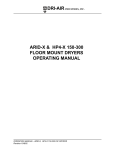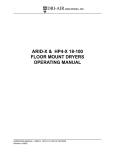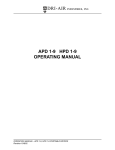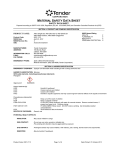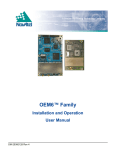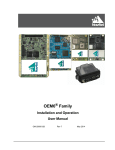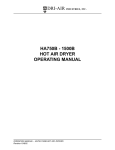Download Dri-Air Industries ARID-X Operating instructions
Transcript
DRI-AIR INDUSTRIES, INC. APD 10-13 HPD 10-13 PORTABLE DRYERS OPERATING MANUAL OPERATING MANUAL - APD 10-13, HPD 10-13 DRYERS Revision 10/8/02 Page 1 DRI-AIR INDUSTRIES, INC. DRI-AIR INDUSTRIES, INC. 16 THOMPSON ROAD P.O. BOX 1020 EAST WINDSOR, CT 06088-1020 Tel. (860) 627-5110 FAX (860) 623-4477 Internet http://www.dri-air.com e-mail: [email protected] Page 2 OPERATING MANUAL - APD 10-13, HPD 10-13 DRYERS Revision 10/8/02 DRI-AIR INDUSTRIES, INC. CONTENTS DRYER OPERATION/FEATURES --------------------------- 4 AIR FLOW SCHEMATIC FOR ARID-X DRYERS -------- 6 AIR FLOW SCHEMATIC FOR HP4-X DRYERS --------- 7 (HIGH PERFORMANCE MODEL SHOW) DRYER CYCLE DIAGRAM ------------------------------------ 8 PLC STANDARD ELECTRICS ------------------------------- 9 INSTALLATION PROCEDURE ----------------------------Electrical Connection ------------------------------------Check for correct motor rotation ----------------------Compressed Air Connection ---------------------------- 10 10 10 10 START-UP PROCEDURE ----------------------------------Standard Electrics ----------------------------------------To Set Temperature: -------------------------------------Microprocessor Control ---------------------------------- 11 11 11 12 CLOSED LOOP LOADING SYSTEM -------------------Receiver Installation -------------------------------------Vacuum Check --------------------------------------------Sensor Adjustment ---------------------------------------Material Flow Adjustment -------------------------------CLL Trouble Shooting -----------------------------------CLL Maintenance ------------------------------------------ 13 13 14 14 15 16 16 DRYER OPERATION TROUBLE SHOOTING --------- 17 DRYER OPERATION-DETAILED DIAGNOSIS -------- 18 DRI-AIR PNEUMATIC ZONE VALVE --------------------- 19 PARTS LISTS ARID-X & HP4-X 150 - 300 ----------------------------- 21 OPERATING MANUAL - APD 10-13, HPD 10-13 DRYERS Revision 10/8/02 Page 3 DRI-AIR INDUSTRIES, INC. DRYER OPERATION/ FEATURES The ARID-X and HP4-X 150, 200, and 300 model dryers are designed for use in high volume injection or extrusion molding applications with usage rates up to 300 lbs. per hour. The ARID-X dryer series is a dual bed design that provides a constant supply of dry air to the material hopper. While one bed is removing moisture from the process air the other is regenerating by heating the desiccant to a high temperature. Once the regenerated bed cools down, the Zone Valve switches the airflow, and the newly regenerated bed is used to desiccate the process air stream. The saturated bed is now regenerated in the same manner, completing the regeneration cycle. The cycle is depicted Page 8. The airflow design of the ARID-X dryers makes the regeneration cycle more efficient because we utilize a small amount of the desiccated process air rather than ambient air to regenerate the desiccant bed. This reduces the impact of the high moisture content of the ambient air, which would contaminate the desiccant bed, and allows the dryer to attain a lower dew point. Please see the Air Flow Schematic on Page 6. HP4-X Design Our patented HP4-X design incorporates 4 desiccant beds where two are stacked, one over the other. This nearly doubles the amount of desiccant available for drying the process air stream, and because of the tower design, the dryer is able to regenerate the desiccant in the same time as our ARID-X series. This allows the dryer to operate in very high humidity conditions without affecting the process air dew point. In fact, this design produces dew point levels of – 40’ to -80’ C for faster more complete drying of your material. Please see the Air Flow Diagram on Page 7. Hopper Design Dri-Air’s ”all stainless” hopper design utilizes a stainless steel inner shell surrounded by a stainless steel jacketed insulation layer. The easily removable stainless steel spreader cone promotes proper material flow to ensure that the material is dried efficiently and no dried material is left at the hopper bottom that needs to be fed out prior to operating. You must ensure that your hopper is adequately sized for your usage rate and is kept filled, to ensure that you have sufficient time to dry the material. Page 4 OPERATING MANUAL - APD 10-13, HPD 10-13 DRYERS Revision 10/8/02 DRI-AIR INDUSTRIES, INC. DRYER OPERATION/ FEATURES (Cont.) Closed Loop Loading System Dri-Air’s closed loop loading system utilizes a dedicated blower, small receiver, filtration system and desiccated air to move the material from the dryer hopper to the molding machine. This eliminates the possibility that your material will be contaminated with moisture as with some other material transfer systems, helping to eliminate defects resulting from moisture contamination. Please refer to the Closed Loop Loader System section of this manual for the proper installation and maintenance. Dryer Controls The ARID-X series can be supplied with the standard PLC Control Module or the advanced Microprocessor Control Module, while the HP4-X series is only available with the Microprocessor Control Module. The PLC Control module includes a PLC control board, display board, temperature controller and touch pad that is programmed for the drying cycle described above. The controller, display board and touch pad indicate the machine status, alarms, set points and allow you to enter operational settings for the dryer. These are explained in more detail later in this manual. The Microprocessor Control Module is one of the most sophisticated yet operator friendly controls on the market. It has many more features than the PLC control module that provide the operator with more control and operational flexibility with the dryer. These features and the operating instructions are covered in detail in the Microprocessor Control Instruction Manual included with your dryer. OPERATING MANUAL - APD 10-13, HPD 10-13 DRYERS Revision 10/8/02 Page 5 DRI-AIR INDUSTRIES, INC. AIR FLOW SCHEMATIC FOR ARID-X DRYERS V O R TE X B LO W E R FILTE R 4-W AY ZO N E VA LV E C O N TR O L TH E R M O C O U P LE H1 XX C O N TR O L TH E R M O C O U P LE H2 VENT R E G E N E R ATIO N AND PROCESS H E ATE R S A FE TY T H E R M A L C O N TR O L TH E R M O C O U P LE L1 C O N TR O L TH E R M O C O U P LE L2 S A FE TY T H E R M A L TO H O P P E R P R O C E S S H E AT E R (A P D 5-9) Page 6 OPERATING MANUAL - APD 10-13, HPD 10-13 DRYERS Revision 10/8/02 DRI-AIR INDUSTRIES, INC. AIR FLOW SCHEMATIC FOR HP4-X DRYERS V O R T E X B LO W E R F ILT E R 4 -W AY Z O N E VA LV E CONTROL T H E R M O C O U P LE H1 XX CONTROL T H E R M O C O U P LE H2 VENT CONTROL T H E R M O C O U P LE * M1 SAFETY THERM AL CONTROL T H E R M O C O U P LE L1 SECONDARY R E G E N E R AT IO N H E AT E R CONTROL T H E R M O C O U P LE * M2 CONTROL T H E R M O C O U P LE L2 SAFETY THERM AL R E G E N E R AT IO N AND PROCESS H E AT E R R E G E N E R AT IO N AND PROCESS H E AT E R SAFETY THERM AL * - CO NTRO L THERM O CO UPLE F O R P L C C O N T R O L O N LY TO H O P P E R P R O C E S S H E AT E R (H P D 5 -9 ) OPERATING MANUAL - APD 10-13, HPD 10-13 DRYERS Revision 10/8/02 Page 7 Page 8 Zo ne 2 C o o ling Va lve Shifts Va lve Shifts Zo ne 1 C o o ling DRYER CYCLE DIAGRAM Zo ne 2 He a ting D rye r C ycle D ia g ra m D e sica nt B e d s Zo ne 1 He a ting DRI-AIR INDUSTRIES, INC. XX OPERATING MANUAL - APD 10-13, HPD 10-13 DRYERS Revision 10/8/02 UNUSED L1 L2 M1 M2 H1 + + - + - + - + - + - + - Tb1 C h0 C h1 C h2 C h3 C h4 C h5 OPERATING MANUAL - APD 10-13, HPD 10-13 DRYERS Revision 10/8/02 Jp3 7 6 Jp2 5 4 Jp1 3 Page 9 L2 R7 R6 R5 R4 C2 Jp5 Jp6 + C18 C17 C12 R37 D0 D1 D2 Rn6 C7 C6 C5 C4 D3 D4 C8 U3 D5 C15 D15 U6 D7 C9 C13 J2 U N U SED D6 INPUTS U4 U8 PO WER U N U SED Smal l PLC03 REV E L1 Br1+ Jp4 U2 C2 U5 D14 D13 D12 D11 D10 D9 D8 C18 C19 J5 C14 DRI-AIR INDUSTRIES EXPANDER BD REV C R3 U18 Tb2 J5 R2 R1 Rn4 Jp7 XX U1 L2 L1 + + OSC2 OSC1 + + Jp7 Rn7 OSC3 14 50 M2 T1 AL2 UNUSED - - - - - SS2 SS1 SS5 SS4 SS3 + + + + + Z1 BOTTOM HEATER Z2 BOTTOM HEATER PROCESS HEATER ARID-X 50-100 Z2 TOP HEATER Z1 TOP HEATER 14 ZONE VALVE 13 MAIN CONTACTOR/TEMP CONTROL 12 UNUSED 11 HIGH TEMP. ALARM (OPTIONAL) 10 ALARM (OPTIONAL) 9A UNUSED 9 110 VAC FROM XFORMER CR1 AL1 J11 UNUSED J11A 8A UNUSED 8 MOTHER BOARD P/N 84100 U7 U9 QT9 + R36 C 20 H.P ONLY 50-100 PROCESS TUBE QT5 QT6 QT7 QT8 GROUND JUMP UNUSED UNUSED HI TEMP. ALARM SIGNAL 7 DAY TIMER SAFETY # 9 TEMP. CONT SIGNAL 50-300 NON H.P. PORT DISPLAY BOARD - P/N 83401 S1 2 11 10 9 8 UNUSED UNUSED 7 DAY TIMER TC1 7 OL1 6 5 4 3 TC1 JP3 1 2 3 DegC X 10 J2 J1 ANALOG TC JP2 D 16 2 1 0 C4 C9 OSC1 C5 C8 S2 C 14 1 C3 U10 C11 C7 C6 JP1 C19 C21 D 20 R38 0 C2 U1 C1 UNUSED C1 C10 C18 C20 Rgain D 15 C1 PW R C12 C13 C 14 C 15 C 16 C 17 H2 1 2 3 TC rev B 1 2 - R 14 C 22 C 23 R 13 R8 R 12 Z1 D 12 Rn3 C 15 C0 U2 C1 C 13 C2 D 10 D 16 C 3 D 14 Rn5 D9 C16 J2 D 13 OSC 3 R 11 D8 C 11 U 2A U11 U5 J118 OSC 1 J12 1 OSC 2 U9 1 R2 D 11 OUT PUTS PLC STANDARD ELECTRICS Rn7 OSC 1 THERMOCOUPLE BOARD DRI-AIR INDUSTRIES, INC. The control package includes a PLC controller which is programmed for the drying cycle previously discussed. The display board indicates the machine status, heater operation and alarms. See section on start up for details. Below are descriptions of the inputs and outputs of the PLC which are used for trouble shooting. A lit LED indicates the input or output is actuated. All inputs are 12 volts AC and all outputs are 110 volts AC and 15 v DC to the heater relays. Refer to the electrical schematic for more detail. C 11 H I TEM P M AIN SAFETY TEM P 50-300 N O N H .P. DRI-AIR INDUSTRIES, INC. INSTALLATION PROCEDURE For all Dri-Air models except ARID-X 10, AHM-1, & PDII Electrical Connection: Open electrical access door on the front of the electric panel enclosure box by turning the disconnect off , loosening the clamping screws and sliding the clamps off the door tabs. Locate the disconnect by following the operating handle down to the electrical panel. Insert the incoming power cable or conduit through the hole provided on the side of the panel enclosure box. « use approved wire and fastening means « Wire incoming power to the top of the disconnect as shown in the diagrams below. NOTE: When 3 wire supplies are used in place of 4 wire supplies, a control transformer is required. 3 PHASE DRYER INSTALLATION CHECK FOR CORRECT MOTOR ROTATION BEFORE RUNNING DRYER To check motor rotation....... Remove front panel to Blower Cabinet (below elec. panel box) so the blower can be observed. Turn on the power to the dryer and press the ON/START touch pad and then immediately press the OFF/STOP touch pad. Observe the cooling fan on the top of the blower motor and verify the fan is turning clockwise. If the motor is not turning clockwise, switch any two adjacent supply wires. Compressed Air Connection: Compressed air is required for ARID-X and HP4-X 150/200/ 300 Floor Mount models to operate the dryer’s Zone Valve. CONNECT COMPRESSED AIR TO INLET ON DRYER SIDE PANEL. Maximum incoming pressure not to exceed 145 psi (1.0 mpa). The pressure gauge on the dryer is factory set to 60 psi. The unit is now ready for operation. Page 10 OPERATING MANUAL - APD 10-13, HPD 10-13 DRYERS Revision 10/8/02 DRI-AIR INDUSTRIES, INC. START-UP PROCEDURE Standard Electrics Turn Power on to Dryer: 1. Power light indicates power to the unit is on. 2. Illuminated Blower Light indicates Blower is on. 3. Flashing Zone light indicates bed is in Regeneration cycle. 4. Steady Zone light means bed is in cooling cycle. 5. Illuminated Heater lights indicate heater is on. Alarm Conditions: 6. Flashing High Temp. alarm indicates an over or under temp alarm. Unit shuts down. 7. Steady High Temp. Alarm light indicates unit has failed. Further diagnostics are required XX To Set Temperature: Press SET button - temperature set display will flash. Press up arrow to increase temperature and down arrow to decrease temperature. Press SET again to enter the new temperature. If the display flashes, the temperature is out of the control range. If the display shows 0000 the thermocouple is not connected or is faulty. OPERATING MANUAL - APD 10-13, HPD 10-13 DRYERS Revision 10/8/02 Page 11 DRI-AIR INDUSTRIES, INC. Microprocessor Control 1. 2. 3. 4. Power light indicates there is power on. After initializing, dri Air will be displayed. Press START to start the dryer. To set the temperature: press SET - right display shows set temp change setting using arrow keys press ENTER to input new setting 5. Left display indicates actual temperature 6. Right display shows dewpoint or set temp press TEMP D.POINT button to change 7. To set high temp alarm: (degrees over setting) press ALARM - right display shows setting change setting using arrow keys press ENTER to input new setting 8. Status block indicates heater on or fault 9. See manual for setting 7-day timer . 10. Configuration of the dryer parameters is done using the setup button. See manual. Page 12 OPERATING MANUAL - APD 10-13, HPD 10-13 DRYERS Revision 10/8/02 DRI-AIR INDUSTRIES, INC. The closed loop loading system uses a separate vortex blower to provide the vacuum and “pressure assist” necessary to move the dried resin from the hopper take-off box to the receiver mounted on the feed throat of the molding machine. CLOSED LOOP LOADING SYSYEM At the start of the loading sequence, the lower proximity switch on the receiver senses there is no material. The blower starts, and the loader valve on the inlet line to the blower is opened. Because the receiver is sealed to the feed throat, a vacuum is created within the take off box, pulling material from the hopper. The outlet of the blower ( pressure side) blows air into the take off box to help move the material to the receiver and close the air loop. When the upper proximity switch on the receiver senses material, the blower is stopped and the loader valve is closed to prevent anymore material from being conveyed and left in the hose to possibly be contaminated with moisture. To operate the system, complete the installation steps detailed below and turn on the system by actuating the toggle switch labeled LOADER on the front of the electrical panel enclosure. If the Dual Closed Loop Loading option has been installed, please consult the Dual Closed Loop Loader Operating Manual enclosed with your dryer. RECIEVER INSTALLATION Prior to installing the receiver, you must inspect the surface of the molding press feed throat that the receiver is being installed upon to ensure that it is clean and flush. Surface irregularities must be removed, or a gasket installed, so that there will be no vacuum leaks between the receiver and feed throat after installation. IMPORTANT If the molding machine is equipped with a slide gate, swing arm, starve feeder, additive feeder, or feed throat vent, you must ensure these are sealed, as the system may not work properly. If it is impractical, or impossible to seal off the aforementioned equipment, Dri Air Industries has a Flap Valve, available for purchase, that will enable the loading system to function properly. To install the receiver, simply drill holes in the bottom flange of the receiver to match the hole pattern on the molding press feed throat and affix the receiver with bolts sufficient to accommodate the operating stresses. A silicone gasket is provided with the receiver to ensure a tight seal between the receiver bottom and the feed throat. Connect the plug for the upper proximity switch into the line labeled H and connect the lower proximity switch plug into the line labeled L. Connect the material feed hose and vacuum hose as shown in drawing 82222 in the appendix to this manual. OPERATING MANUAL - APD 10-13, HPD 10-13 DRYERS Revision 10/8/02 Page 13 DRI-AIR INDUSTRIES, INC. VACUUM CHECK Prior to production operation of the loading system, we strongly recommend that you ensure the loading system is properly sealed. To test the seal, follow the steps detailed below. While the loader is running, close the hopper slide gate and remove the material wand and attached hose from the takeoff box. Check the vacuum level by placing your hand over the wand. Return the wand to the takeoff box. Remove the hose from the bottom port of the blowback filter canister. Place your hand over the filter canister port. Compare this vacuum level to the level observed at the material wand. The two vacuum levels should be the same. Any difference between the vacuum levels is caused from leaks in the loading system. Check for loose hoses, missing gasket on the cyclone, or other possible sources of leaks described below. The most likely source is the seal between the feed throat and receiver, or the configuration of the feed throat and material feeder associated with the molding press. The presence of vacuum leaks at these locations may exhibit the following characteristics: n Material in the receiver may be seen to bubble or move when loading, as a leak at the feed throat causes air to be drawn in at the bottom of the receiver rather than from the take off box. n Poor transfer of material from the take-off box to the receiver. n Large amounts of material or dust being pulled into the blowback filter cannister. If any of these occurrences are observed, the steps to improve the vacuum seal detailed in the previous section on Receiver Installation will be required. PROXIMITY SENSOR ADJUSTMENT Page 14 The proximity sensors supplied with the receiver may require adjustment to operate properly. When positioning the sensors, ensure that they are placed as close as possible to the outer surface of the receiver as they operate by sensing the density of the material in the receiver. Vertically position the lower sensor to set the material level at which the load cycle will initiate and the upper sensor to set the material level at which the load cycle will stop. CAUTION: Do not overfill the receiver as material may be drawn back into the blowback filter canister. OPERATING MANUAL - APD 10-13, HPD 10-13 DRYERS Revision 10/8/02 DRI-AIR INDUSTRIES, INC. To adjust the sensor’s sensitivity, turn the adjustment screw on the back of the sensor. The adjustment screw turns a 20 turn potentiometer with a clutch to prevent over adjustment. If you are unsure as to the current setting of the sensor, turn the screw 20 turns counterclockwise. The LED should light with no material in front of the sensor. Turn the screw 4-6 turns clockwise and proceed as directed below. With no material in front of the sensor, the LED on the back of the sensor should be lit. If not, turn the adjustment screw located on the end of the sensor counterclockwise until the LED turns on. With material in front of the sensor, the LED on the back of the sensor should be off. If not, turn the adjustment screw clockwise, until it turns off. MATERIAL FLOW ADJUSTMENT Material flow to the receiver should be continuous and smooth. Irregularities in flow rate and volume can be affected by the position of the material wand inserted into the take-off box or the density of the resin. To adjust the flow, take the steps detailed below. Upon initial operation of the loading system, push the wand in until it stops. Then pull it out 1 to 2 inches and tighten the set screw on the take-off box material outlet. Operate the loading system and observe how the material flows into the receiver. If the flow rate is not as desired, the wand can be adjusted out to reduce the flow of material conveyed, or in, to increase the amount. Typically, loading times are 5-6 seconds for a 2” receiver and 15-20 seconds for the 4” receiver. If the material flow is irregular, with “slugs” of resin being delivered to the receiver, the wand is most likely pushed too far into the take-off box. This “chokes” off the air flow required to convey the material, causing the irregular flow. To remedy this condition, pull the wand out slightly and the material will flow more evenly and quickly. If little or no material is conveyed and there are no blockages in the take-off box or material hose the wand may be pulled too far out of the take-off box. Push the wand in until you get the desired flow rate. OPERATING MANUAL - APD 10-13, HPD 10-13 DRYERS Revision 10/8/02 Page 15 DRI-AIR INDUSTRIES, INC. BASIC TROUBLE SHOOTING for CLOSED LOOP LOADING SYSTEM Material will not feed. 1. Ensure the proximity sensors are adjusted and working properly. Both sensors LED’s should be lit when the receiver is empty. Check that the sensors are tightened on the bracket and the cable connectors are tight and correct. 2. Check system for leaks. Tighten hose clamps. Check seal at receiver/feed throat interface by comparing vacuum levels as directed in in previous section on Receiver Installation. 3. Ensure the blower operates. Check the electrical system to see if the relay is working and that the blower overload is not tripped. Trip window will be orange/yellow if tripped.Check to see that the rotation is correct. (clockwise) 4. Ensure that the compressed air is connected to the system and the pressure regulator is set to 60 psi. Does the air valve open when the system calls for material? The air line to the valve can be easily disconnected by pushing in on the plastic sleeve and removing the hose. The air line should be pressurized when the system is loading. 5. Ensure the drain valve at the bottom of the filter canister is closed properly. CLOSED LOOP LOADER MAINTENANCE Daily Maintenance: Clean filter when loader is not working. The filter is cleaned automatically with an air blast at the start of each loading cycle. The canister needs to be drained periodically by opening the valve at the bottom of the canister. Gently bang on the side of the cannister with your hand to loosen any fines and close the valve. Monthly Maintenance: Clean filter sock by removing the quick clamp on the filter and removing the top cover. Remove the bag assembly and blow off with compressed air. Reinstall bag assembly, top cover and quick clamp checking that the seal is proper. This maintenance may need to be performed more frequently if your material is dusty, or less frequent if your material is clean. We strongly recommend it be performed every 6 months regardless of material conditions Tighten all hoses and hose clamps and check for leaks. Page 16 OPERATING MANUAL - APD 10-13, HPD 10-13 DRYERS Revision 10/8/02 DRI-AIR INDUSTRIES, INC. DRYER OPERATION TROUBLE SHOOTING The new Dri-Air Standard PLC and MICROPROCESSOR Electrics were designed for quick diagnosis of problems. The following steps should be done before proceeding with other diagnostic steps. 1. Check the Power Circuit: a. Incoming fuses or circuit breaker b. All dryer fuses: Each fuse, with the exception of the main fuses, has a blown fuse indicator light that illuminates when the fuse is blown. c. Is power supplied to the unit? d. Check heater continuity using a volt ohmmeter. 2. Compressed Air: a. Is compressed air connected with at least 60 PSI b. Check water separator and drain if necessary c. Pressure gage should read 60 PSI 3. Air Flow Circuit: a. Ensure Zone Valve position corresponds to the regeneration cycle by noting the valve’s zone position as detailed in the section discussing troubleshooting the Pneumatic Zone valve on page 15 of this manual. b. Make sure that all hoses are connected, not crushed, and free from obstructions. c. Inspect filter and make sure cover is tight and the filter is clean. 4. Control Circuit: a. Using the PLC/MICRO Display Panel ZONE indicator lights as a guide for the dryer regeneration cycle, check that all inputs/outputs are proper for the part of the regeneration cycle that the machine is in. 5. Operating Conditions: a. Check the process temperature. It should not be set below 140° F (60° C) because the unit will go into high temp alarm. OPERATING MANUAL - APD 10-13, HPD 10-13 DRYERS Revision 10/8/02 Page 17 DRI-AIR INDUSTRIES, INC. DRYER OPERATION DETAILED DIAGNOSIS (PLC Controlled Dryer) For Micro Controlled dryers please see the Microprocessor Control Instruction Manual Machine will not start: Power light is not on. 1. Check incoming fuses inside control box to see if they are tripped or blown. Reset circuit breakers by turning them off and then on. 2. Check small fuses (FU1 & FU2) next to contactor. The LED will be lit if they are blown. Replace if necessary by opening the fuse holder and put new fuse into holder. 3. Check that incoming power to the unit is proper. 4. Check safety snap discs. Alarm light is flashing: Unit will not run. Main contactor is not pulling in. 1. Check the motor overload OL1 located in the panel. If it is tripped, the window will show as orange/yellow. Reset overload by pushing in the reset button. Machine will not run: High Temp Alarm Light flashing: This indicates that the temperature has exceeded the high limit programmed into the temperature control or the set temperature can not be reached. Press stop and restart machine holding in the start button. Monitor the actual temperature to see if it exceeds the set point or can not reach the set point. If it can not reach set point, see section below. Machine will not run. High Temperature Alarm on, not flashing: 1. This indicates an “open” thermocouple or the temperature in the desiccant tower exceeded 900° F. Machine will not reach temperature: 1. If the process heater light is not lit. A. Check output from temperature controller and input to PLC. B. Check the thermocouple. The tip should be in the middle of the hose. 2. If the process heater light is lit. A. Check fuses. B. Check solid state relays. C. Check that the air flow is correct. D. Check blower rotation. E. Check heater for continuity. Page 18 OPERATING MANUAL - APD 10-13, HPD 10-13 DRYERS Revision 10/8/02 DRI-AIR INDUSTRIES, INC. Check the limit first by pressing the SET button on the temperature control and holding until AL is displayed. The setting shown indicated the amount over set point that the alarm will be actuated. It is factory set to 50°F (30°C) and should not be set below 30°F (16°C) or it will actuate too soon. If the temp exceeds the set point check the following: 1. Remove the hose from the top of the hopper to check air flow. There should be air flow out of the hopper with a suction on the hose. If there is little or no flow, check the inlet hose. 2. Inspect the filter to make sure that it is clean and not affecting the air flow. 3. Check the solid state relays to see if one of the solid state relays has failed on. Using an ammeter or voltmeter on the output to the heater, see if there is power when the LED is not lit which will indicate a failed relay. 4. Check the Zone Valve position. DRI-AIR PNEUMATIC ZONE VALVE TROUBLESHOOTING The Dri-Air Pneumatic Zone Valve is designed to provide very little flow restriction and no leakage. It incorporates an AirFlow Diversion Valve controlled by a single solenoid valve. The solenoid valve simultaneously actuates air cylinders on each side of the Air-Flow Valve, altering air flow through the dryer. When a new regeneration cycle begins, the valve diverts air to the newly regenerated tower and exhausts wet regeneration air from the desiccant bed being regenerated. This allows for a constant supply of dry air to flow to the material hopper. Air pressure should be kept at 60 psi to ensure reliable operation. Trouble shooting is easy. To access the Air-Flow Diversion Valve, remove either side panel on the dryer cabinet. The valve is located in the “Blower Section”, positioned on the upright separating the blower section from the tower section of the cabinet. To determine which zone the valve is set to, locate the two ports on the top of the valve (one on each end) for exhausting wet regeneration air and place your hand over an exhaust port to feel for air flow. Air will be flowing from the port that is set to regeneration. (Note, as you face the dryer’s electrical panel enclosure, the exhaust port on the right side of the valve is for ZONE 1 and the port on the left side is for ZONE 2.) Compare your findings to the lighted ZONE Position LED on the control panel display to ensure that they correspond with each other. If they do not correspond or if air is exhausting from both ports, the valve is not working properly. Check the following: OPERATING MANUAL - APD 10-13, HPD 10-13 DRYERS Revision 10/8/02 Page 19 DRI-AIR INDUSTRIES, INC. 1. Check all air line connections to make sure they are tight. 2. Check air lines to ensure they are not cracked or broken. 3. Check incoming air pressure (60 psi min.). 4. Check operation of solenoid valve (See below). To check operation of solenoid valve, remove front panel to blower compartment. The valve is located on the right-hand wall, directly connected to the air pressure regulator. Located on the top of the valve is a button, that when depressed will actuate the valve. With air pressure supplied to the dryer, use a small screw driver to depress the actuator button. Observe the action of the Air Diversion Valve. If the Diversion Valve operates, the solenoid valve is operating correctly. Page 20 OPERATING MANUAL - APD 10-13, HPD 10-13 DRYERS Revision 10/8/02 DRI-AIR INDUSTRIES, INC. APD 10 - 13 and HPD 10 - 13 DESCRIPTION GENERAL CLOSED LOOP LOADER ELECTRICAL NOTE: TO ORDER BLOWERS OR OVERLOAD REFER TO PART NUMBER ON ITEM. *: IEC CONTACTOR USED IN ALL FM, PD & HM DRYERS AND CLL POWER PACKS WITH SERIAL NUMBERS GREATER THAN D14650 APD HPD Dryer Filter Element Zone Valve Thermocouple (Process) Thermocouple (Tower) Desiccant 80082 (Lbs/Machine) Tower Clamp Tower Gasket Pressure Switch Regulator SMC Valve (No Load System) SMC Valve (Load System) Caster (Swivel) Caster (Fixed) 81331 81331 83786 83786 82174 82174 82175 82175 74 lbs. 136 lbs. 82197 82197 83815 83815 82813 82813 82995 82995 84220 84220 84122 84122 82311 82311 82312 82312 Filter Element Blowback Valve Proximity Switch (PLC) Proximity Switch (Micro) 82389 82695 81180 82298 Disconnect (230v) Disconnect (460V) Temperature Control (RKC CB-100) Main Board Display Board Thermocouple Board Current Transformer Signal Transformer (230v) Signal Transformer (460v) Main Contactor (230v) Main Contactor (460v) IEC Contactor IEC Contactor * Solid State Heater Relay Single Pole Relay (option) Double Pole Relay (CLL) Four Pole Relay (Dual CLL) Dual Solid State Board Toggle Switch Safety Thermal Switch Transformer .150(Auger Feed) Transformer .250(Auger Mix) Dewpoint Sensor Solid State Timer (Blowback) Solid State Timer (Cleanout) Solid State Timer (Auger Delay) 82389 82695 81180 82298 STD MICRO 82714 82308 84016 84100 83401 84049 83437 NR NR 82904 82270 80576 84860 82302 82496 80587 81050 NR 80466 80221 81169 81821 81908 83318 83527 83442 82714 82308 NR 82071 82072 NR 84131 83817 82246 82904 82270 80576 84860 82302 82496 NR 81050 82870 80466 80221 81169 81821 81908 83318 83527 83442 HEATERS 230V Regeneration (Cone Style) HP Center (Flat Style) Process OPERATING MANUAL - APD 10-13, HPD 10-13 DRYERS Revision 10/8/02 400V 480V 575V 81091 81923 81367 81494 82722 82506 82517 84046 82672 82047 82047 82696 Page 21 DRI-AIR INDUSTRIES, INC. NOTES: Page 22 OPERATING MANUAL - APD 10-13, HPD 10-13 DRYERS Revision 10/8/02 DRI-AIR INDUSTRIES, INC. NOTES: OPERATING MANUAL - APD 10-13, HPD 10-13 DRYERS Revision 10/8/02 Page 23























